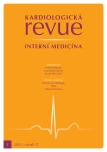Cardiac resynchronization therapy – when should it be indicated and for whom?
Authors:
L. Riedlbauchová
Authors‘ workplace:
Antiarytmické oddělení, Kardiologická klinika 2. LF UK a FN v Motole, Praha
Published in:
Kardiol Rev Int Med 2015, 17(1): 32-36
Category:
Cardiology Review
Overview
Currently, cardiac resynchronization therapy holds an irreplaceable position in the treatment of some patients with symptomatic heart failure. Its positive impact on heart failure symptoms, hemodynamics or quality of life has been proved in many randomized clinical trials which have also demonstrated that this therapy is able to induce reverse remodeling of the heart leading to improved systolic ventricular function and regression of cardiac dilatation. Such changes result in a reduced rate of hospitalization for heart failure decompensation and improved total and cardiac mortality. However, the efficacy of cardiac resynchronization therapy is inter‑ individually variable. Therefore it is necessary to identify appropriate candidates for cardiac resynchronization therapy. This topic has become the subject of the following article that is founded on the recent recommendations of the European Society of Cardiology.
Keywords:
cardiac resynchronization therapy – biventricular pacing – cardiac pacing – heart failure, dyssynchrony
Sources
1. McMurray JJ, Adamopoulos S, Anker SD et al. ESC Guidelines for the diagnosis and treatment of acute and chronic heart failure 2012: The Task Force for the Diagnosis and Treatment of Acute and Chronic Heart Failure 2012 of the European Society of Cardiology. Developed in collaboration with the Heart Failure Association (HFA) of the ESC. Eur Heart J 2012; 33: 1787– 1847. doi: 10.1093/ eurheartj/ ehs104.
2. Cohn JN, Archibald DG, Ziesche S et al. Effect of vasodilator therapy on mortality in chronic congestive heart failure. Results of a Veterans Administration Cooperative Study. N Engl J Med 1986; 314: 1547– 1552.
3. Cleland JG, Daubert JC, Erdmann E et al. Longer‑term effects of cardiac resynchronization therapy on mortality in heart failure [the CArdiac REsynchronization– Heart Failure (CARE‑ HF) trial [extension phase]. Eur Heart J 2006; 27: 1928– 1932.
4. Bristow MR, Saxon LA, Boehmer J et al. Cardiac‑ resynchronization therapy with or without an implantable defibrillator in advanced chronic heart failure. N Engl J Med 2004; 350: 2140– 2150.
5. Cleland JG, Daubert JC, Erdmann EE et al. The effect of cardiac resynchronization on morbidity and mortality in heart failure. N Engl J Med 2005; 352: 1539– 1549.
6. Zareba W, Klein H, Cygankiewicz I et al. Effectiveness of cardiac resynchronization therapy byQRS morphology in the multicenter automatic defibrillator implantation trial‑ cardiac resynchronization therapy (MADIT‑ CRT). Circulation 2011; 123: 1061– 1072. doi: 10.1161/ CIRCULATIONAHA.110.960898.
7. Linde C, Abraham WT, Gold MR et al. Randomized trial of cardiac resynchronization in mildly symptomatic heart failure patients and in asymptomatic patients with left ventricular dysfunction and previous heartfailure symptoms. J Am Coll Cardiol 2008; 52: 1834– 1843. doi: 10.1016/ j.jacc.2008.08.027.
8. Tang AS,Wells GA, Talajic M et al. Cardiac‑ resynchronization therapy for mild‑ to‑ moderate heart failure. N Engl J Med 2010; 363: 2385– 2395. doi: 10.1056/ NEJMoa1009540.
9. Brignole M, Auricchio A, Baron‑ Esquivias G et al. 2013 ESC Guidelines on cardiac pacing and cardiac resynchronization therapy: the Task Force on cardiac pacing and resynchronization therapy of the European Society of Cardiology (ESC). Developed in collaboration with the European Heart Rhythm Association (EHRA). Eur Heart J 2013; 34: 2281– 2329. doi: 10.1093/ eurheartj/ eht150.
10. Khan NK, Goode KM, Cleland JG et al. Prevalence of ECG abnormalities in an international survey of patients with suspected or confirmed heart failure at death or discharge. Eur J Heart Fail 2007; 9: 491– 501.
11. Nieminen MS, Brutsaert D, Dickstein K et al. EuroHeart Failure Survey II (EHFS II): a survey on hospitalized acute heart failure patients: description of population. Eur Heart J 2006; 27: 2725– 2736.
12. Doshi RN, Daoud EG, Fellows C et al. Left ventricular‑based cardiac stimulation post AV nodal ablation evaluation (the PAVE study). J Cardiovasc Electrophysiol 2005; 16: 1160– 1165.
13. Brignole M, Gammage M, Puggioni E et al. Comparative assessment of right, left, and biventricular pacing in patients with permanent atrial fibrillation. Eur Heart J 2005; 26: 712– 722.
14. Hoijer CJ, Meurling C, Brandt J. Upgrade to biventricular pacing in patients with conventional pacemakers and heart failure: a double‑blind, randomized crossover study. Europace 2006; 8: 51– 55.
15. van Geldorp IE, Vernooy K, Delhaas T et al. Beneficial effects of biventricular pacing in chronically right ventricular paced patients with mild cardiomyopathy. Europace 2010; 12: 223– 229. doi: 10.1093/ europace/ eup378.
16. Dickstein K, Bogale N, Priori S et al. The European cardiac resynchronization therapy survey. Eur Heart J 2009; 30: 2450– 2460. doi: 10.1093/ eurheartj/ ehp359.
17. Curtis AB,Worley S Adamson PB et al. Biventricular pacing for atrioventricular block and systolic dysfunction. New Engl J Med 2013; 368: 1585– 1593. doi: 10.1056/ NEJMoa1210356.
18. Cleland JG, Freemantle N, Erdmann E et al. Long‑term mortality with cardiac resynchronization therapy in the Cardiac Resynchronization‑ Heart Failure (CARE‑ HF) trial. Eur J Heart Fail 2012; 14: 628– 634. doi: 10.1093/ eurjhf/ hfs055.
Labels
Paediatric cardiology Internal medicine Cardiac surgery CardiologyArticle was published in
Cardiology Review

2015 Issue 1
Most read in this issue
- TDM of digoxin in clinical practice
- Drug interaction and current clinical practice
- Cardiac resynchronization therapy – when should it be indicated and for whom?
- TDM of antibiotics in clinical practice
